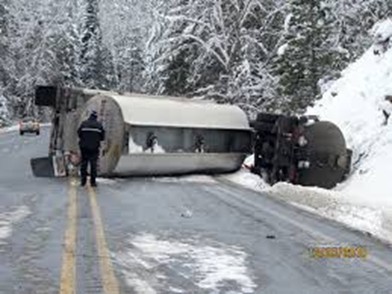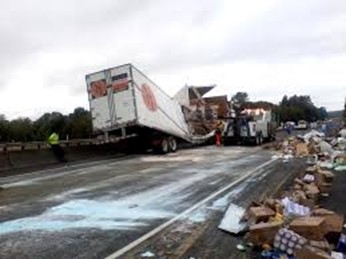
Long-haul trucking is a vital component of the transportation industry, ensuring that goods reach their destinations across vast distances. Drivers are often tasked with navigating diverse terrains and unpredictable weather conditions, all of which can significantly impact the safety of their journey. One of the most crucial factors in ensuring safe travel is managing speed and stopping distances, particularly during adverse weather conditions. For long-haul truckers, understanding how various weather patterns affect braking systems is essential to preventing accidents and maintaining control of their vehicles.
The following article explores how weather conditions such as rain, snow, ice, fog, and high winds can influence braking distances, cause potential accidents. In these scenarios, expert trucking professionals play a crucial role in determining fault. These experts use their specialized knowledge of trucking operations, safety protocols, and vehicle mechanics to analyze the circumstances surrounding an accident. By reviewing factors such as weather conditions, braking performance, and the driver's actions, they can provide valuable insights into the causes of the accident and help establish who may be at fault.
When rain begins to fall, it creates a layer of water on the road that can significantly reduce tire traction. Wet roads increase the likelihood of hydroplaning, which occurs when a layer of water builds up between the tires and the road surface, causing the tires to lose contact with the road. This can lead to a considerable increase in stopping distances, as the truck's braking system has to work harder to stop the vehicle while maintaining control.
On wet roads, braking efficiency decreases, as the tires are not gripping the road surface as effectively as they would on dry pavement. For long-haul truckers, this means they must adjust their speed and allow more distance to stop. A general rule of thumb for wet conditions is to reduce speed by approximately 10-20%, depending on the severity of the rain and road conditions.
Snow and ice present some of the most challenging conditions for truckers, significantly increasing stopping distances. Both snow and ice reduce tire friction, making it harder for the truck's brakes to slow down the vehicle. In icy conditions, it can take up to 10 times longer to stop a truck than it would under dry conditions. This is especially dangerous on highways and mountain roads, where truckers may be required to descend steep inclines or navigate sharp turns.
In snowy conditions, the road surface becomes slippery and unpredictable, and truckers must adjust their braking strategy. Trucks should be slowed down gradually, and excessive braking or abrupt movements should be avoided. Additionally, truckers should leave plenty of space between themselves and other vehicles, as stopping distances can vary significantly, even with the best braking systems.
Fog doesn’t directly affect the friction between tires and the road, but it does have an indirect impact on stopping distances. Reduced visibility can make it difficult for truckers to see obstacles or changes in the road ahead, leading to delayed reactions. Fog often causes truckers to slow down, but they must do so with caution. Even when driving at lower speeds, it’s crucial to maintain an adequate following distance, as stopping distances may increase if sudden braking is needed.
Truckers should rely on their headlights, fog lights, and mirrors to navigate through dense fog. Modern trucks with adaptive cruise control systems and automatic emergency braking (AEB) can help maintain a safe distance from other vehicles, but it’s essential to drive cautiously and at a speed that’s appropriate for the visibility conditions.
High winds can cause instability in 18-wheelers, particularly when driving through open fields or over bridges. Crosswinds can push the truck off course, requiring the driver to make frequent adjustments to their steering and braking. While wind doesn’t directly affect the friction between tires and the road, it can alter the truck's stability and make it harder for the driver to maintain control.
In windy conditions, stopping distances may increase because the truck may be harder to stop if it is being pushed off course or swaying. Drivers should keep both hands on the wheel, reduce speed, and be cautious of passing vehicles that might create additional wind turbulence.

Anti-lock braking systems (ABS) are designed to prevent the wheels from locking up during braking, especially in slippery conditions like wet, snowy, or icy roads. ABS helps maintain vehicle stability and prevents skidding by automatically modulating brake pressure, allowing the driver to maintain steering control. This can significantly reduce stopping distances during adverse weather conditions, particularly when sudden or hard braking is necessary.
In the past, truckers had to rely on their instincts and braking experience to prevent the wheels from locking. With ABS, truckers can apply the brakes as forcefully as needed without fear of losing control, making it a crucial safety feature, particularly on wet or icy roads.
Collision mitigation systems (CMS) are becoming increasingly popular. These systems use radar, cameras, and sensors to detect objects or vehicles ahead and provide warnings to the driver if a collision is imminent. In some cases, the system will even automatically apply the brakes to prevent or mitigate an accident.
CMS is particularly valuable in conditions where visibility is limited, such as fog or heavy rain, or when there is a need for sudden braking. The system can help reduce stopping distances by anticipating the need for a stop before the driver has a chance to react, especially in high-risk scenarios such as tailgating or driving at high speeds in poor weather.
Electronic stability control (ESC) is another essential technology that helps long-haulers maintain control of their vehicles, particularly in dangerous weather conditions. ESC works by automatically applying individual brakes to specific wheels when it detects that the truck is losing traction or control, such as when the vehicle begins to skid or slide.
ESC can be especially useful in slippery or icy conditions, where trucks are at a higher risk of skidding or jackknifing. By helping to stabilize the truck, ESC improves safety and reduces the risk of accidents, which is particularly crucial for long-haul truckers driving through snow, ice, or wet conditions.
Adaptive cruise control is an advanced feature that helps truckers maintain a safe distance from other vehicles while on the road. This system uses sensors and radar to monitor the distance between the truck and the vehicle ahead and automatically adjusts the truck’s speed to maintain a safe following distance.
In weather conditions like rain, snow, or fog, adaptive cruise control can be particularly useful, as it helps maintain a consistent speed and distance from other vehicles without the need for constant adjustments by the driver. This can reduce fatigue and prevent accidents caused by sudden changes in speed.
Automatic emergency braking (AEB) is an innovative safety feature that automatically applies the truck’s brakes if the system detects an impending collision and the driver fails to react in time. This can be particularly useful in weather conditions where visibility is poor, or road conditions are slippery.
AEB systems rely on a combination of radar, sensors, and cameras to monitor the road and identify potential obstacles. If the system determines that a collision is likely, it will engage the brakes to prevent or reduce the severity of the impact. This system has proven to be highly effective in preventing rear-end collisions and reducing the risk of accidents.
Managing speed and stopping distances in long-haul trucking is crucial for ensuring the safety of the driver, cargo, and other road users. Adverse weather conditions such as rain, snow, ice, fog, and high winds can significantly affect braking distances, making it essential for truckers to adjust their driving and braking strategies accordingly.
Fortunately, modern braking technologies like anti-lock braking systems (ABS), collision mitigation systems (CMS), electronic stability control (ESC), adaptive cruise control (ACC), and automatic emergency braking (AEB) have made it easier for truckers to safely navigate through hazardous conditions. These systems are not only designed to enhance safety but also help reduce the risk of accidents caused by weather-related challenges.
By staying informed about weather conditions, regularly maintaining braking systems, and utilizing advanced safety features, long-haul truckers can significantly improve their safety on the road, even in the most challenging weather conditions.